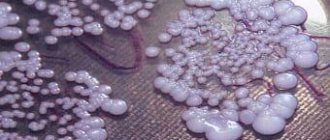White plaque on the head
The male penis contains thyson glands. They produce a lubricant that protects the head from rubbing. The discharge has a specific smell and thick consistency. If a guy neglects the rules of hygiene, lubricant mixed with dirt and drops of urine accumulates on the penis. A white coating forms on the head in men. But milky discharge does not always appear due to uncleanliness. Sometimes they are a symptom of a serious illness.
Causes of white secretion
Natural lubricant has a sour smell and looks like a greasy film covering not only the head, but also part of the base. If a man is not bothered by other symptoms, he should wash his penis twice a day with warm water and baby or antibacterial soap. Then the amount of discharge will decrease and the unpleasant odor will disappear. It is recommended to contact a urologist when:
- burning sensation during and after urination
- redness of the foreskin and glans
- discomfort during erection and sexual intercourse
- swelling of the reproductive organ
Grease that looks like cottage cheese indicates thrush. Fungal disease also occurs in healthy men, but the immune system constantly suppresses the infection, preventing it from multiplying. The problem appears when the body's defenses decrease. For example, after a flu or cold. A man can become infected with thrush through unprotected sex. Candida fungi need to be treated with special medications, which are selected by a urologist. If the disease is advanced, the patient’s sensitivity of the head decreases. Because of this, problems with erection occur. The infection multiplies and gradually invades the urethra, causing pyolocystitis. The inside of the urethra becomes covered with purulent formations. They lead to a narrowing of the urinary canal. The disease is accompanied by severe and sharp pain. The fungus spreads to the kidneys, increasing the risk of pyelonephritis. The patient's entire genitourinary system suffers. White plaque on the head of the penis does not always indicate thrush. If a man is promiscuous and rarely uses condoms, he should visit a venereologist or andrologist. Be sure to get tested to rule out:
- chlamydia
- syphilis
- gonorrhea
- genital herpes
One of the signs of sexually transmitted diseases can be a putrid odor, reminiscent of rotten fish or eggs. Suspicion should be raised by small rashes on the head of the penis. With genital herpes, the penis becomes covered with small blisters, which open on their own after a few days and turn into painful sores. The wounds do not heal for a long time and may bleed periodically. Syphilis is also characterized by pimples and ulcers, but they do not cause discomfort and disappear without treatment. In men, white discharge occurs with HIV and psoriasis. If an examination by a venereologist shows that the patient does not have sexually transmitted diseases, it is necessary to donate blood for sugar. Plaque on the penis may indicate diabetes.
Causes
Always the presence of discharge of an unusual nature indicates the development of an infection in the human body, which, if left untreated, will take a chronic form. As a result of this process, a man’s health is weaker, various inflammatory processes begin to develop, which gradually lead to early aging and infertility. In addition to curdled discharge, there may be additional symptoms such as:
- Itching;
- Painful sensations when urinating;
- Statements;
- Redness.
Very often, cheesy discharge in men indicates the development of candidiasis in the man’s body, or, as this disease is also called, thrush.
Most often, treatment is carried out with a special type of antibiotics. But such signs do not always indicate this particular disease. Very often there are cases when candidiasis develops in parallel with other diseases. Only a doctor can accurately establish a diagnosis and prescribe effective treatment after conducting certain laboratory tests.
If you have the above symptoms, you should definitely and immediately make an appointment with an andrologist.
Diagnosis and treatment
An examination by an andrologist or urologist consists of two parts:
- The doctor asks the patient about symptoms, collects anamnesis
- The specialist then conducts a visual examination of the penis and takes a swab from the glans. It's not painful, but may be slightly unpleasant
If necessary, the doctor will issue a referral for a blood test. After receiving the results, treatment is selected. A man must follow all instructions and recommendations. During the treatment period, patients are advised to abstain from sex. It is impossible to independently determine the reason why a white coating appears on the head. You cannot use folk remedies or pharmaceuticals if there is no definitive diagnosis. Otherwise, the state of health only worsens, and the disease enters the chronic stage. While research is being carried out, you can wash the penis with decoctions of chamomile, string or calendula. Herbs soothe itching and reduce discomfort. A man is recommended to change his underwear daily, and clean underpants must be ironed with a hot iron. Infections and fungi die at high temperatures. The patient’s well-being is improved by a special diet. Doctors recommend eliminating sweets, honey, mayonnaise and flavored yoghurts from your diet. Sugar creates favorable conditions for fungal growth. Carbonated drinks and sweets, animal fat, processed foods and fried foods are prohibited. Men benefit from porridge, vegetable and fruit salads, dietary meat, cottage cheese, kefir and light soups. The diet is suitable for patients with psoriasis, dysbiosis, diabetes and thrush. It restores intestinal microflora, improves immunity and improves skin condition. At home, you can use “Tetracycline ointment”, always one percent, and “Malavit”. The drugs reduce inflammation, swelling and discomfort. But they do not remove the cause of the cheesy discharge, so you cannot do without consulting a doctor.
Doctor visit
As already noted, problems of the sexual sphere in men are dealt with by a highly specialized specialist – an andrologist. Men of all ages turn to this doctor for diagnosis and treatment of such problems.
Thanks to his narrow specialization, the andrologist knows exactly all the structural features of the male reproductive system and can prescribe the most effective treatment.
In our clinic, consultations on such issues are conducted by a high-level specialist with appropriate education and significant experience. The first appointment of patients is carried out according to an established and developed plan, and consists of the following stages:
- First, the doctor conducts a preliminary examination;
- Collects a complete medical history;
- Gives directions for certain tests.
Only if the results of all the tests performed are available, the specialist will make a diagnosis and begin to develop a treatment plan. The doctor will coordinate each step with the patient and tell him what he needs to do to deal with the problem as quickly as possible.
Useful information on the topic:
- Tests for sexually transmitted infections
- Appointment with a urologist at the clinic
- Diagnosis of urological diseases
- Urethral swab
- Diagnosis of skin diseases
- Treatment of discharge
- Diagnosis of urethral discharge
- Chlamydia
- Pelvic ultrasound
- Ultrasound at home
- Ultrasound of the prostate
- Causes of discharge in women
- Causes of discharge in men
- Diagnosis of sexually transmitted infections
Syphilis
Dangerous venereal pathology. The causative agent is Treponema pallidum. The disease progresses very slowly. The danger is that the first signs of pathology in 90% of cases go unnoticed. Against this background, the disease becomes chronic.
Primary syphilis is indicated by a white coating on the head and an unpleasant odor. Its tint may also be yellowish.
Lymph nodes enlarge near the area where the chancre appeared. If a chancre appears on the penis, a change in the size of the lymphatic vessels is observed. This is a fairly rare symptom that occurs in 7-10% of cases.
With secondary syphilis, the following symptoms appear:
- the appearance of specific spots on the body;
- formation of papules (plaques);
- hair loss (hair falls out specifically - in “islands”).
Gonorrhea
A sexually transmitted infectious pathology, which is provoked by a gram-negative diplococcus - gonococcus.
The reason for the development is unprotected sex. The risk group includes gay people, as well as men who often change sexual partners.
Even if a person has already been diagnosed with gonorrhea, he is always at risk of becoming infected a second time.
Main symptoms:
the appearance of pus on the mucous membrane;
- change in color of the scrotum (redness);
- pain during urination;
- white plaque on the bridle;
- swelling of the scrotum;
- frequent urge to go to the toilet;
- discomfort in the suprapubic area.
Additionally, yellow patches of hair in the groin are likely to appear.
White plaque on the penis is characterized by a sharp, unpleasant “aroma”. Over time, its amount increases, and bloody impurities appear in the urine.
Prevention of pathological discharge in men
Any of the diseases described can be avoided by taking precautions:
- Protect yourself during sex with a condom.
- Wash the genitals correctly at least once a day. The head is opened and the space under the foreskin is cleared of secretions. For washing, use products without fragrances and dyes.
- Wear loose underpants made of natural material.
- Do not self-medicate with antibiotics.
- Visit a urologist or andrologist at the first signs of an unhealthy condition.
- STDs and thrush should be treated together for regular sexual partners.
Attention! Inflammation in the head, if left unchecked, can lead to problems with potency and infertility.
Tumor processes
The development of oncological processes provokes disruption of the sebaceous glands of the external secretion. This leads to increased formation of smegma.
Common pathologies:
- Keir's disease. This is an intraepithelial form of the oncological process. In 80% of cases the head is affected. The color of the plaque on the penis is dirty white. It is very dense and difficult to clean. Glossy red nodules appear above the foreskin;
- cancerous lesion of the penis. A malignant neoplasm is formed from erectile tissue cells. The coating on the penis is specific, white, very sticky. Another characteristic symptom is the appearance of mushroom-like growths on the head.
Dermatitis
The pathology is provoked by both an allergic reaction and an infection. Classic symptoms are a white coating and itching in the affected area.
Additionally, limited red swelling appears on the penis and near it. Specific bubbles also form. Sometimes exudation is observed.
The root cause is the body's hypersensitivity to lubricants or contraceptives.
In 55% of cases, the development of contact urticaria is observed. The unpleasant symptom disappears within a few hours.
An allergic reaction can be very life-threatening. Symptoms of anaphylactic shock sometimes appear during contact with a condom.
Chlamydia
An infectious pathology that is provoked by Chlamydia trachomatis. Occurs in the background:
- lack of intimate hygiene;
- a history of other pathologies that are sexually transmitted;
- genetic predisposition.
Main symptoms:
- frequent urge to go to the toilet;
- white plaque on the scrotum;
- increase in general temperature;
- painful sensations in the scrotum;
- swelling of the external genitalia;
- discomfort during sex;
- redness of the external genitalia;
- pain when urinating;
- discomfort in the perineum.
When not to worry
The white coating on the foreskin is called smegma. It is a lubricant produced by the body to protect the body from mechanical damage. It is a secretion of the tizon glands, which are located on the external genitalia.
The white substance has a cheesy consistency. It is localized in the preputial sac. If smegma accumulates in large quantities, it is clearly visible on the head of the penis.
Increased secretion production is observed in young men at the time of puberty.
You should not worry if:
- there are no formations on the skin (erosions, blisters, nodules);
- there are no unpleasant sensations (itching, burning, pain);
- there is no redness of the tissues.
In case of non-compliance with the rules of intimate hygiene, the proliferation of pathogenic and opportunistic microorganisms is observed in the smegma environment. The result is an increased risk of developing balanoposthitis.
Phimosis
A narrowing of the foreskin that prevents exposure of the head of the penis. If pain is present, this indicates that the pathology has become chronic.
A white coating on the penis is formed due to the accumulation of viscous secretions under the foreskin. The occurrence of the symptom is due to the inability to thoroughly rinse the head.
As the disease progresses, the foreskin cracks and the pain intensifies.
The appearance of pinpoint pustules or erosions on the penis indicates the addition of an infection.
In the absence of timely treatment, paraphimosis—strangulation of the head of the penis—progresses.
Lichen sclerosus
Another name is kraurosis of the penis. This is a chronic pathology, which is characterized by focal atrophy of the skin and mucous membranes.
One of the specific signs is a white coating under the head in men. It usually forms inside the preputial sac.
Additional symptoms:
- the presence of shiny plaques;
- the appearance of papules on the affected areas (their shade varies from white to pearlescent);
- atrophy of the skin next to the penis;
- the appearance of horny plugs at the mouths of hair follicles;
- itching in the perianal area.
This is a fairly rare pathology. It is detected in 10-15% of cases.
Balanitis
Why does my head itch? The appearance of this symptom is explained by the development of balanitis - an inflammatory lesion of the penis. Develops against the background:
- fungal infections;
- penetration of harmful bacteria into the body;
- viral infections.
The risk group includes people suffering from psoriasis and diabetes.
Symptoms:
- pain during urination;
- the appearance of purulent impurities in the urine;
- itching on the head (accompanied by a strong burning sensation);
- enlarged lymph nodes in the groin;
- redness on the head;
- general malaise;
- pain in the head while walking;
- weakness;
- ulceration of the head.











